
Budgeting for facility asset repairs and replacement projects is the furthest thing from a simple process. With a limited budget and a backlog of repairs to tackle, how can you be sure you’re making the right spending decisions? The Technical Assurance team can be your partner in facility asset management and help simplify the budgeting process for you.
Our ON-PNT® portal includes built-in business intelligence that effectively prioritizes capital and repair budgets, maximizing your return on investment. The Budget Solution tool helps you generate ad-hoc budget plans with the option of incorporating inflation, asset deterioration, and specific constraint scenarios. This allows you to visualize the impact of various annual spend plans on both your deferred capital backlog and overall portfolio conditions.
Budgeting for Various Facility Assets

The first step in configuring the ON-PNT® Budget Solution is choosing the asset type(s) to be included in the budget plan. You can budget for roof systems, walls, parking structures, and even fall protection.
The tool will take step-by-step through the process to create a Budget Plan. You’ll select whether you want to run a repairs or replacement report, and then you’ll continue in the process of selecting conditions, budget constraints, start and end dates, and any other parameters that apply to your situation. The Budget Solution works to assess what needs done and triage based on a number of factors.
Triaging Spend Based on Scientific Metrics

Each building asset’s Condition Index (CI), Mission Dependency Index (MDI), System Criticality Index (SCI) and Total Cost of Ownership (TCO) are considered in ON-PNT®’s triage methodology.
- Condition Index (CI) – An objective, repeatable and scientific metric intended to provide a baseline for system condition determined via an assessment of the system
- Mission Dependency Index (MDI) – Calculated by ranking each building based on its importance to the organization’s mission and operations
- System Criticality Index (SCI) – Comes into play when including other building systems into the management program. For example, if safety system projects are considered when triaging, they tend to be very critical systems; and therefore, one of the most critical projects for any building portfolio.
The Output: Your Customized Budget Plan

The ON-PNT® Budget Solution’s project triage provides an unbiased solution to the complex problem of ranking and prioritizing capital and repair projects, offering repeatable and objective analysis using established facility asset management standards built from IFMA, APPA, ASTM and other engineering standards.
The resulting Budget Plan includes the following fields:
- Facility System – Specifies the asset type
- SF – Specifies the total asset square footage
- Replace (or Repair) Order – Ranks the replace (or repair) priority sequence
- Delayed Year – Specifies the year the project falls into the spend plan
- Triage Replace (or Repair) – Scores the asset replace (or repair) priority on a scale of 0 (least) to 100 (most) important
- Mission Dependency Index (MDI) – Ranks asset criticality as it relates to client mission on a scale of 0 (least) to 100 (most) important
- Condition Index (CI) – Quantifies asset condition, calculated by system age, and defect type, severity, and quantity on a scale of 0% (Failed) to 100% (Excellent)
- Condition – Verbally quantifies asset condition, as dictated by the CI (Failed, Very Bad, Bad, Poor, Fair, Good, or Excellent)
- Project Replace (or Repair) Budget – Total project costs including construction, multipliers, and fees
- Replace (or Repair) Cumulative – Cumulatively sums the project budgets each project year to the point of hitting the specified annual spend
Once your Budget Plan is created, you can then export it as an Excel spreadsheet or a PDF. This will be an incredibly useful tool for you in getting repairs and replacement projects approved.
Spend Plan: See How Annual Spend Impacts Deferred Maintenance Backlogs and Asset Conditions
The ON-PNT® Spend Plan provides you with further insight by qualifying how annual spends impact their deferred maintenance backlogs and roof conditions over the period of the plan.
In general, a balanced Spend Plan reduces clients’ deferred backlog over the duration of the plan, resulting in optimized roofing replacement and repair investment that extends the service life of building systems and reduces total cost of ownership.
See the impact of two divergent Spend Plans below:

Explore the ON-PNT® Budget Solution Further
If you’re interested in the ON-PNT® Budget Solution, we’d be happy to walk you through the platform to show what’s possible. Contact us today to request a consultation!
Download Our Sustainable Roof Asset Management White Paper
Interested in learning more about reducing your maintenance backlog and moving toward a more sustainable approach to facility asset management? Download our white paper.

